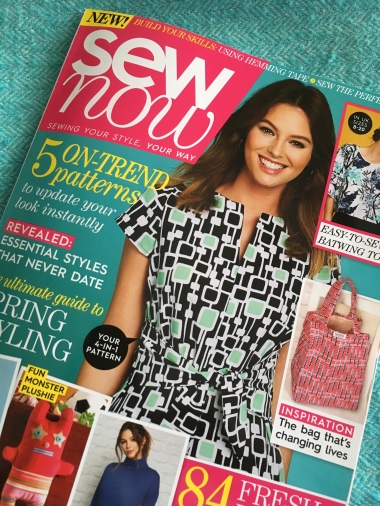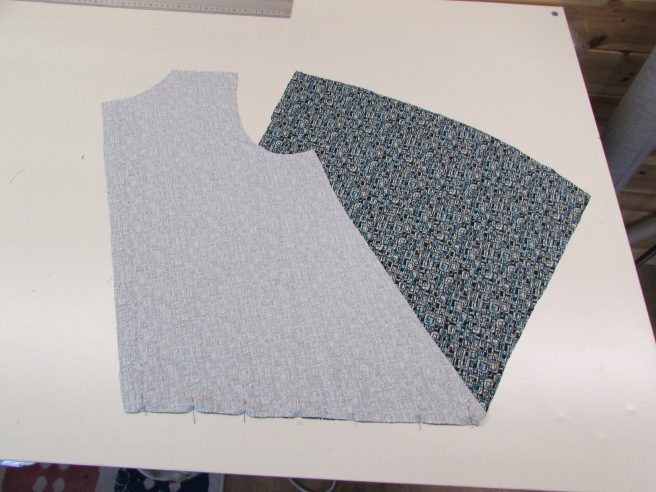
I can finally publish a blog all about the making of this dress so I hope you enjoy it and find it helpful or insightful…
I was very excited when Sew Now magazine asked me to review a pattern for them. What an opportunity! Editor Sam asked me to suggest 3 patterns that I’d like to make which were ‘me’ so I thought about the various patterns that were around at the moment and which ones I wouldn’t mind having a go at.
It’s funny but when you’re given the opportunity to push something to the top of your ‘make’ pile it really concentrates the mind. I thought the best way of seeing lots of patterns together was to go to The Fold Line where there’s a brilliant online database of virtually any pattern brand you can think of. I spent a happy hour (or two) browsing until I eventually settled on 4 patterns to submit. They were the Farrow dress from Grainline, the Talvikki sweatshirt by Named Clothing, Ivy pinafore by Jennifer Lauren Handmade and the Landgate jacket by Merchant and Mills. I spent quite a while sourcing suitable fabrics for each of the garments too so that, once Sam had made her final pattern choice, I could tell her the fabrics I thought would work well for it.
Because I really liked all the patterns, and they were quite diverse, I didn’t mind which one Sam chose. I’ve made a dress a little like the Farrow already and it’s actually one of my favourites. What made the Farrow different is the diagonal seams which bisect the front and back, and there are pockets set into the front seams. It has sleeveless and long sleeve variations too. I was stupidly excited when it arrived speedily in the post courtesy of The Draper’s Daughter 
There was a slight hiccup with the first fabric I chose because the supplier hadn’t got quite enough so we had to go with my second choice, a lovely turquoise squared design viscose crepe at £12.99 per metre kindly supplied by Ditto Fabrics in Brighton. 
And so to begin….
Because Grainline are an American brand it’s important to remember that their sizing bands are different to UK and European sizing so I took my measurements and then chose accordingly. I’m usually a cutter not a tracer with patterns (always have been because it was never suggested to me there was an alternative, patterns are there to be cut up and used)
The Farrow doesn’t have loads of pieces and, apart from a curiously-shaped front piece for the pocket which needs a bit of space, I do think the lay plan is a bit over generous although the largest sizes will inevitably need more fabric overall. On a wide width fabric-especially if it is plain-you could easily reduce the quantity needed although I would urge you to double-check before buying if you’re not sure.
Luckily for me the Ditto fabric doesn’t have a distinct one-way design so I could interlock the pieces successfully and get the dress out of 2m60 instead of the suggested 3m20 (incidentally another factor of being a US pattern is that the fabric widths and quantities are in Imperial not metric so you’ll need to convert these)


Once cut out it’s a very straightforward sew. The instructions are clear although the diagrams could perhaps be a little bit bigger and also the right and wrong sides of the fabric are coloured the opposite way around to most other patterns I’ve ever used. This could lead to confusion and mixing up which side you’re supposed to be sewing so you’ll need to concentrate!

 Stitching the lower edge of the pocket, the crossed pins higher up mark the pivot points for the seams creating the upper edge.
Stitching the lower edge of the pocket, the crossed pins higher up mark the pivot points for the seams creating the upper edge.

Since first making the dress it’s been through the wash once and I’ve noticed the top edges of the pockets have stretched slightly because they are on a bias grain. I would suggest for future makes that you use a strip of iron-on interfacing approx 3cms x the top width of the pocket to reinforce the edge and stop it from stretching and bagging out of shape.
Once both fronts have their pockets sewn it’s a case of matching the centre front seams and stitching.

So far, sew good. Everything from now on was pretty simple. The neck is faced, as are the cuffs-this gives them a really nice crisp finish to the edge. I’d made another Farrow when the pattern first arrived and I used a contrast fabric for this, so that it has one of those little secret details that only you know about-that’s one of the things I love about making my own clothes, their uniqueness.



One final thing that I changed was the hem. I decided I wanted to use contrast bias binding to give it a nice finish, the hi-lo hem means whatever finish you choose it will be partly visible at the back.



Obviously you can machine the hem up if you wish but the point is I wanted the stitching to be barely visible and hand-stitching is by far the best way to achieve this.
The final detail was to use a button and hand-sewn loop at the back neck closure (the pattern calls for a hook and eye but I don’t think they stay done up very well and a button looks much nicer anyway)

So there it is, the Farrow dress is a satisfying, moderately quick sew. I’ll definitely be making a sleeveless one for the summer in something a bit lighter, a chambray or soft linen would look nice, or a cotton shirting in a check or stripe could look really interesting if you’re up for the challenge of matching on the those pockets and diagonal seams! Broderie Anglais fabric would look gorgeous too!



I really enjoyed writing the article for Sew Now and was dead chuffed to be asked. I spent a long time considering which patterns I’d like to make and which fabrics would be suitable for any of them. I was more than happy with editor Sam’s selections in the end. Funnily enough, getting everything into 300 words was the hardest part! There were so many things I felt it was important to talk about (it’s a review after all and there are facts that I’d want to know about if I’m considering spending £15 on a pattern and I thought they were important to include) and I still wanted it to sound like ‘me’ too. With strict editing I got it all in there and I’ve gone into greater detail here on the blog. 
I was so thrilled when my copy of the magazine came through the post! I’ve had photos of garments I’ve made featured before in a few publications but this is the first article I’ve been asked to write, I’d love it to be the first of many (hint hint)
Thank you for all the feedback I received when it first appeared and I hope you’ve enjoyed finding out about my writing experience in more detail.
Happy Sewing
Sue xx

I saw the article and it is good to see your process for choosing the patterns and writing the article. What a great opportunity and you have a lovely dress at the end of it!
LikeLiked by 1 person
thank you Tamsin, I really enjoyed it. We must get together again before too long!
LikeLike
This is lovely Sue. I read your article with interest as this is a pattern I’ve had my eye on for a while. It’s good to read a more in depth review here too, I think I’ll more than likey be purchasing this soon.
LikeLiked by 1 person
that’s good to know Sam, I really wanted it to be an honest appraisal of the pattern because it doesn’t help anyone if it’s all positive with no balance or truthful observations I think.
LikeLike
Congrats on the feature! This pattern has been on my radar for for awhile and I appreciate your review. It surprises me a little that the measurements aren’t in both metric and Imperial…
LikeLiked by 1 person
As a US pattern I don’t think they feel the need to cater to the European market by using both systems! Thank you for kind words
LikeLike
Hi Sue. Just read your review in 2019 and very comprehensive. I’m debating this pattern at the moment. Thank you.
LikeLiked by 1 person